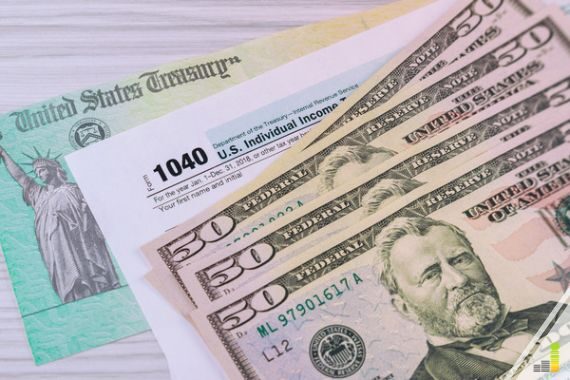Tax filing time is stressful for many Americans. Yet once you complete your taxes, the fun part begins – getting your tax refund. Of course, the happiness of receiving a few thousand dollars in a tax refund makes up for the stress. But how long does it take to get a tax refund?
In 2022, the average tax refund was $3,012, almost $200 more than in 2021, when the average was $2,827.
Americans can use the tax refund money in many ways. It can be used to pay bills, take a vacation, decrease debt, boost savings, invest in stocks, or take advantage of a Roth IRA.
Taxpayers receive a refund when they pay more federal or state taxes than they owe. A tax refund is essential for many people, and they often wait apprehensively and worry about how quickly they will receive their tax refund.
Table of Contents
How Long Does It Take To Get Your Tax Refund
According to the IRS, the agency issues nine out of ten refunds in less than 21 calendar days, provided they are e-filed and the direct deposit option is used. But the website also says tax returns requiring additional review may take longer.
Despite what the website states, many people know the wait can be longer, especially if you filed a paper return or requested a refund as a check. The IRS indicates that the time may be as much as four weeks or more for taxpayers filing paper returns to receive their refund.
If you e-filed but requested a check, expect to wait a month for your refund.
Mailing a paper return and requesting direct deposit takes about four weeks.
The longest wait is mailing a paper return and requesting a refund by check. This process takes about two months.
The IRS Faced Challenges
The Internal Revenue Service (IRS) struggled during the COVID-19 pandemic. The unprecedented challenge of filing millions of tax returns when workers were away from the office made processing returns challenging.
Over the past decade, the IRS has had its budget cut, causing chronic understaffing problems. It has also been hampered by a lack of access to new technology. The pandemic exacerbated these deficiencies.
In fact, in 2021, the IRS relied on manual processing of millions of returns, causing excessive delays. According to the Tax Advocate Service,
“At the close of the 2021 filing season, the IRS had 35.3 million returns awaiting manual processing. As the IRS is preparing to begin the 2022 filing season, it is poised to carry over millions of unprocessed returns and millions of pieces of taxpayer correspondence, resulting in even longer delays for taxpayers who have been patiently waiting for far too long.”
Is 2023 Better for The IRS?
The IRS began the year with a ten million tax return backlog. But the agency has received more funding through last year’s Inflation Reduction Act, allowing it to hire roughly 5,000 more customer service agents and install new technology.
As a result, the IRS has more people to handle the flood of returns this year. Consequently, the IRS is processing claims about ten percent faster than last year.
Also, Americans are filing their returns earlier. The combination of faster processing and earlier filings should expedite tax refund issuance.
Check Your Refund Status
If 21 days have passed and you are still wondering how long it takes to get your refund, then it’s time to check the “Where’s My Refund?” article on the agency’s website.
The IRS allows American taxpayers to check the status of their income tax refund as early as 24 hours after e-filing. But the time length may be as long as four weeks if you submit a paper return.
The information on this page is updated overnight each day. To use the tool, you must provide the tool-specific information: your Social Security number, filing status, and the exact refund dollar amount on your return.
The tool tells users:
- when the IRS received their return,
- when the refund was approved, and
- when the refund was sent
Another option is to use the IRS2Go app on your mobile phone. Similar to the “Where’s My Refund” page, the app provides a status update 24 hours after e-filing a return.
You can also consult a tax refund calendar to get a rough estimate of when you can expect your refund.
A third option is to call the toll-free number provided by the IRS.
Reasons Your Refund Is Delayed
Multiple reasons exist for a late tax refund. The IRS causes some, and some result from a taxpayer’s specific situation.
IRS Operational Delays
The first category is IRS operational delays. The agency processes millions of returns. However, it is often understaffed or dealing with antiquated technology. Both of these issues are reasons for delays.
Next, service interruptions may be caused by processing tax returns that need correction or answering mail from a taxpayer.
Return Specific Reasons
Filing on Paper
The main reason for a late refund is filing on paper and requesting a check. This IRS estimates a refund will be received in two months in this case.
The bottom line is that e-filing and direct deposit are much faster.
Claiming The Earned Income Tax Credit
An automatic delay will occur if the taxpayer claims the Earned Income Tax Credit (EITC). Congress stipulated in the Protecting Americans from Tax Hikes (PATH) Act passed in 2015 the agency must hold withhold refunds until February 15.
The IRS said earlier in 2023, refunds with this claim would be available by February 28 if the taxpayers filed early and asked for direct deposit.
Claiming The Additional Child Tax Credit
Similarly, an automatic delay to at least February 15 will happen if someone claims the Additional Child Tax Credit (ACTC).
Return Has Errors or Is Incomplete
Tax returns with errors or incomplete information will cause a delay. In these cases, the IRS will contact the filer by mail for more details. The agency’s website states,
“If we need more information to process your return, we’ll contact you by mail. If we’re still processing your return or correcting an error, neither Where’s My Refund? or our phone representatives will be able to provide you with your specific refund date.”
Common errors include a typo or a miscalculation. However, if you use tax filing software such as TurboTax, a miscalculation should not occur.
Sometimes filers select the wrong filing status or make another error preventing processing.
Skipping a line or filling out a form incorrectly, or other mistakes will prevent a return from being processed.
Fraud
On occasion, the IRS detects identity theft. For instance, if someone else used your Social Security number on a different return, your tax refund will be delayed.
Other Reasons
Other potential reasons for late refunds include requiring a more comprehensive review, filing an amended tax return, or garnishment. Also, an amended tax return may cause a wait for your refund of up to 20 weeks.
Additionally, if you owe a tax debt or child support payments, the IRS may take all or a part of your refund.
How Long Does It Take To Get Your State Tax Refund
Some may ask how long it takes to get your state tax refund. The answer varies. If you use electronic tax filing methods, they often require you to file your federal return before your state return.
However, in practicality, state refunds arrive before federal ones because they are more straightforward.
In general, expect your state tax refund in 30 days or less. But depending on the state, your money may arrive in as little as two weeks.
The best solution is to check your state tax agency’s website. Some have tracking tools or apps similar to the IRS.
What To Do With Your Tax Refund?
The average tax refund in 2023 will probably be around $3,000. Of course, higher-income earners tend to receive more than lower-income earners. But whether you receive a few hundred or a few thousand dollars, a good idea is to put the money to work for your future.
The leading option is to pay down debt following either the debt avalanche or snowball methods. Paying off high-interest rate debt first is the debt avalanche method.
Rising interest rates have made credit cards expensive, with a punishing average annual percentage rate (APR) of roughly 20 percent.
Paying off credit card debt can lower your monthly cash outflow. Alternatively, you can follow the debt snowball method and start by paying off the smallest balance.
Another good option is to build your emergency fund to deal with unexpected expenses. Unfortunately, many Americans have insufficient money to deal with unforeseen expenses.
Having six to twelve months of monthly payments in a savings account can provide peace of mind. CIT Bank is one good option to stash your savings as they have competitive rates.
If you already have a robust emergency fund, today’s higher interest rates are attractive for savers. Some high-yield savings and money market accounts are paying nearly four percent.
Short-term U.S. Treasury bills and bonds ranging from 1-month to 1-year pay over four percent. In addition, Series I Savings Bonds have many advantages and usually have higher interest rates than savings accounts.
Another option is to invest in stocks or bonds to build wealth and generate a passive income stream for retirement.
Speeding Up Your Tax Return Refund
The bottom line is filing electronically and requesting direct deposit is the faster way to receive your tax refund. In addition, completing your tax return earlier helps avoid the rush around the federal and state tax filing deadlines.
This article originally appeared on Wealth of Geeks.
What are you doing with your tax refund this year?
About the author: Prakash Kolli is the founder of the Dividend Power site. He is a self-taught investor, analyst, and writer on dividend growth stocks and financial independence. His writings can be found on Seeking Alpha, InvestorPlace, Business Insider, Nasdaq, TalkMarkets, ValueWalk, The Money Show, Forbes, Yahoo Finance, and leading financial sites. In addition, he is part of the Portfolio Insight and Sure Dividend teams. He was recently in the top 1.0% and 100 (73 out of over 13,450) financial bloggers, as tracked by TipRanks (an independent analyst tracking site) for his articles on Seeking Alpha.
I’m John Schmoll, a former stockbroker, MBA-grad, published finance writer, and founder of Frugal Rules.
As a veteran of the financial services industry, I’ve worked as a mutual fund administrator, banker, and stockbroker and was Series 7 and 63-licensed, but I left all that behind in 2012 to help people learn how to manage their money.
My goal is to help you gain the knowledge you need to become financially independent with personally-tested financial tools and money-saving solutions.






Leave a Reply